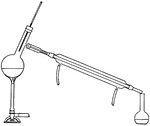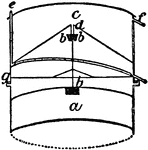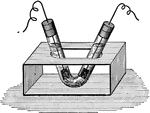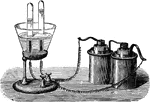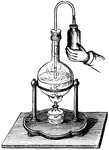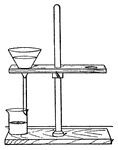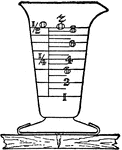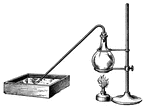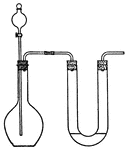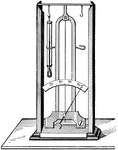This science ClipArt gallery offers 206 illustrations of equipment and apparatus used in chemistry experiments and procedures, and includes images of full apparatus as well as parts, such as lab beakers and flasks. See also the Balances gallery in the Simple Machines collection.

Distillation
Apparatus used for distillation, separating liquid from the impurities contained in it. A, reservoir;…

Fractional Distillation
An illustration of various fractional distillation devices. fractional distillation must be used in…
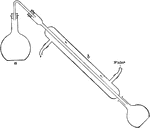
Distilling Apparatus
In order to rid water of impurities, it is required to boil water, then condense the steam to make it…

Electric Apparatus
This illustration shows an apparatus used to examine the conductivity of solutions.

Electric Furance
"The electric furnace is a device by which a very high temperature is obtained by using a large arc…

Electrolysis of Hydrochloric Acid
"Hydrochloric acid...is placed in the tubes a. The threeway stopcocks b are turned so that there is…

Filter Stand for Chemistry Experiments
The paper filter is folded and placed in a funnel. The filter stand holds the funnel and filter over…

Paper Filter
Paper filter used in chemistry experiments. The filter on the left is folded to fit into a funnel. The…

Apparatus Used for Fractional Distillation
"An apparatus setup for fractional distillation of water." —The Encyclopedia Britannica 1910

Funnel with Inverted Mercury Thermometer
"Pass the tube of an air thermometer or of an inverted mercury thermometer through a cork in the neck…
!["For measuring the gas concentration, pressure and temperature, use may be made of an apparatus of the type shown [here]." —The Encyclopedia Britannica 1910](https://etc.usf.edu/clipart/36100/36102/app_gas_36102_mth.gif)
Apparatus for Measuring Gas Concentration Pressure and Temperature
"For measuring the gas concentration, pressure and temperature, use may be made of an apparatus of the…

Gas Liquidation
"M. Cailleter's apparatus is represented. The gas under experiment is contained in a stout glass tube…

Gas Liquidation
"M. Cailleter's apparatus is represented. The gas under experiment is contained in a stout glass tube…

Apparatus Used to Seperate Volatile Gases
"If it be required to separate the helium which is often found in the gases given off by a thermal spring,…
McLeod Gauge
A McLeod gauge isolates a sample of gas and compresses it in a modified mercury manometer until the…
McLeod Gauge
A McLeod gauge isolates a sample of gas and compresses it in a modified mercury manometer until the…
Vacuum Gauge
A vacuum gauge is used to measure the pressure in a vacuum — which is further divided into two…

Glass Furnace
"Glass is made by melting together sand, an alkali, and calcium carbonate in pots of fire-clay." Brownlee…
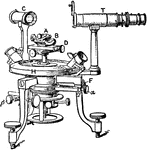
Horizontal-Circle Goniometer
The goniometer is an instrument for measuring the angles of crystals. Nicolaus Stena in 1669 determined…

Vertical Circle Goniometer
The goniometer is an instrument for measuring the angles of crystals. Nicolaus Stena in 1669 determined…
Heated Pumice
This illustration shows a mixture of gases passing over a headed pumice to forming steam.

Heated Test Tube
A test tube stoppered and connected to an inverted beaker, that will be used to collect the gas generated…

Chemical Hood
A chemical hood is used to hold substances with odorous or toxic fumes. The hood contains a vacuum in…

Volume Composition of Hydrogen Chloride
Apparatus used to make hydrogen chloride using sulfuric acid and hydrochloric acid.
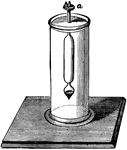
Hydrometer
"The Fahrenheit hydrometer of constant volume is made of glass, the bulb at the bottom being loaded…

Hydrometer
Nicholson's Hydrometer, consists of a hollow cylinder of metal with conical ends, terminated above by…

Hydrometer
Nicholson's Hydrometer, consists of a hollow cylinder of metal with conical ends, terminated above by…

Hydrometer
Fahrenheit's Hydrometer, is generally constructed of glass, and differs from Nicholson's in having at…
Hydrometer
"It is composed of a hollow ball of glass, or metal, with a graduated scale rising from its upper part,…
Hydrometer
"Determines the specific gravity of any given liquid. A hollow ball, C, rises to a graduated scale while…

Hydrometer of constant weight
"As generally made, a hydrometer of constant weight consists of a glass tube near the bottom of which…
Common Hydrometer
A hydrometer is an instrument used to measure the specific gravity (or relative density) of liquids;…

Nicholson Hydrometer
"The Nicholson hydrometer of constant volume is a hollow cylinder carrying at its lower end a basket,…
Standard hydrometer
"Hydrometers of variable immersion are usually light hollow glass spindles weighted by shot or mercury."—Finley,…
US Internal Revenue hydrometer
"The US Treasury Dept. and its internal revenue servie uses a series of carefully adjusted hydrometers…

Cylindrical Iron Retort and Condenser
"Wood is heated in cylindrical iron retorts. the volatile materials are cooled, and while a portion…

Iron Retorts
"...crude petroleum is distilled in iron retorts connected with condensers and receiving tanks." -Brownlee…
Lactometer
"Galactometer. A species of hydrometer for determining the richness of milk by its specific gravity."…

Lamp chimney and candle
"With a lamp chimney or other large glass tube, a perforated cork, two pieces of glass tubing 4 and…
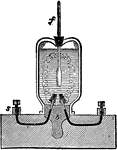
Lenz's Apparatus
"Lenz's apparatus for measuring the heat given off by an electric current." -Hawkins, 1917
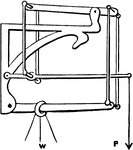
Compound Lever
"Sometimes it is not convienent to use a lever sufficiently long to make a given power support a given…
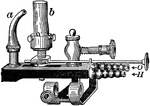
Lime-Light Burner
a is the burner tip for an oxy-hydrogen flame, and b is the cylinder of quicklime.
